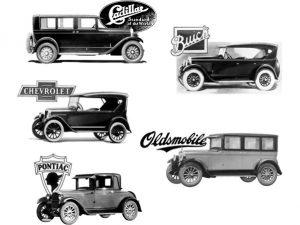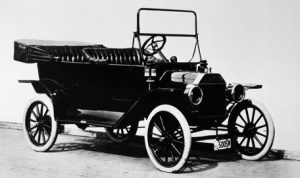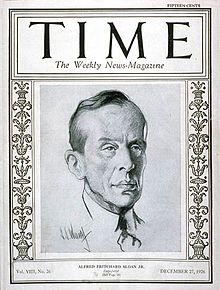A ladder to success

“I’m going to democratize the automobile,” Henry Ford said in 1909. “When I’m through, everybody will be able to afford one, and about everybody will have one.”
 Using the highly cost-effective assembly-line method of producing cars he had developed and with the Model T, his Ford Motor Car Company took control of the market.
Using the highly cost-effective assembly-line method of producing cars he had developed and with the Model T, his Ford Motor Car Company took control of the market.
However, Ford’s vision was to make the car a commodity. He is famous for saying “Just like one pin is like another pin when it comes from the pin factory, or one match is like another match when it comes from the match factory” and “You can have any colour you like as long as it’s black”.
It gave Ford the ability to grow and develop the early market, but also created the opportunity that Alfred Sloan and General Motors were to exploit to overtake Ford and become market leaders.
 Sloan was born in New Haven, Connecticut and studied electrical engineering at the Massachusetts Institute of Technology (MIT).
Sloan was born in New Haven, Connecticut and studied electrical engineering at the Massachusetts Institute of Technology (MIT).
He went on to become president and owner of Hyatt Roller Bearing, a company that made roller and ball bearings. They started to supply early automotive companies like Oldsmobile with the ball bearing they needed.
Then, in 1916, on the back of the rapidly expanding car market, Hyatt merged with a number of other companies to become the United Motors Company, which in turn soon became part of General Motors Corporation. Sloan became Vice-President of GM, then President in 1923, and finally in 1937 Chairman of the Board.
Sloan’s approach to business management including managing diverse operations with financial statistics such as return on investment was to make him famous in that field, but he demonstrated a flair for marketing and consumer insight as well.
He realized that consumer tastes changed and evolved, and that not everyone’s taste was the same. While a basic cheap and functional car suited many it didn’t suit everyone especially more affluent customers who wanted more power, more style and to demonstrate their status.
So he came up with a concept he called “a car for every purse and purpose“. The idea was to have five distinctive brands which did not compete with each other (which form lowest cost to most expensive went) – Chevrolet, Pontiac, Oldsmobile, Buick and Cadillac but offered choice and variety to different groups of customers. Customers could, as their income grew, move from brand to brand, moving up what Sloan called “the ladder of success.”
Sloan had introduced a five way segmentation into the market.
To meet the need for changing tastes and to encourage people to want to come back and buy another car he introduced the idea of frequent styling changes, so if you wanted to keep up with the latest trends you would need to buy a new car. It is often labelled as the introduction of “planned obsolescence” though in reality it was mirroring what was going on in other industries like fashion.
The changes, along with Ford’s resistance to change, worked and GM overtook Ford to industry sales leadership by the early 1930s, a position it was to retain for over 70 years.
Sloan’s ladder of success was to prove a ladder to success for GM